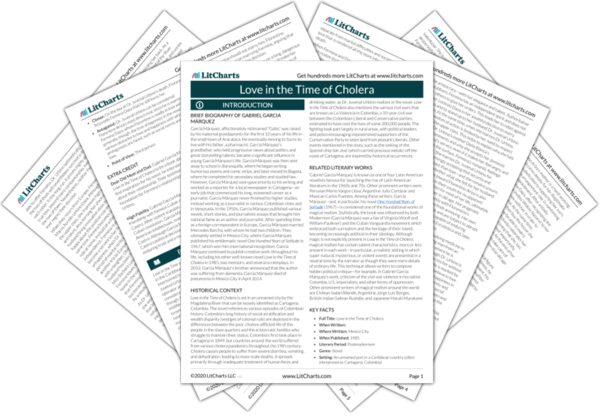Welcome to the LitCharts study guide on Gabriel García Márquez's Love in the Time of Cholera. Created by the original team behind SparkNotes, LitCharts are the world's best literature guides.
Love in the Time of Cholera: Introduction
Love in the Time of Cholera: Plot Summary
Love in the Time of Cholera: Detailed Summary & Analysis
Love in the Time of Cholera: Themes
Love in the Time of Cholera: Quotes
Love in the Time of Cholera: Characters
Love in the Time of Cholera: Symbols
Love in the Time of Cholera: Literary Devices
Love in the Time of Cholera: Theme Wheel
Brief Biography of Gabriel García Márquez

Historical Context of Love in the Time of Cholera
Other Books Related to Love in the Time of Cholera
Key Facts about Love in the Time of Cholera
- Full Title: Love in the Time of Cholera
- When Written:
- Where Written: Mexico City
- When Published: 1985
- Literary Period: Postmodernism
- Genre: Novel
- Setting: An unnamed port in a Caribbean country (often interpreted as Cartagena, Colombia)
- Climax: On the day of Dr. Juvenal Urbino’s death, Florentino Ariza tells Fermina Daza that he still loves her.
- Antagonist: Dr. Juvenal Urbino can be considered Florentino Ariza’s most direct rival, since he is married to Fermina Daza, whom Florentino is madly in love with. More generally, though, the true antagonists in the novel are the various obstacles to love and happiness with which the protagonists are faced, such as social norms and unrequited love.
- Point of View: Third person
Extra Credit for Love in the Time of Cholera
Dear Old Mom and Dad. Gabriel García Márquez meant for Love in the Time of Cholera to be a book about love and aging. To find inspiration for his novel, he interviewed his own parents about their relationship. Their testimony serves as the foundation for Fermina’s relationships with Florentino and Dr. Urbino.
High Fidelity. Gabriel García Márquez sustained a long friendship with famous Cuban revolutionary leader Fidel Castro. After violent scandals marred the reputation of the Cuban revolution, García Márquez, unlike many other Latin-American intellectuals, maintained a close relationship with Castro. Although García Márquez strongly criticized some of Castro’s political decisions, the two men were bound by enduring trust and a mutual love for literature.







